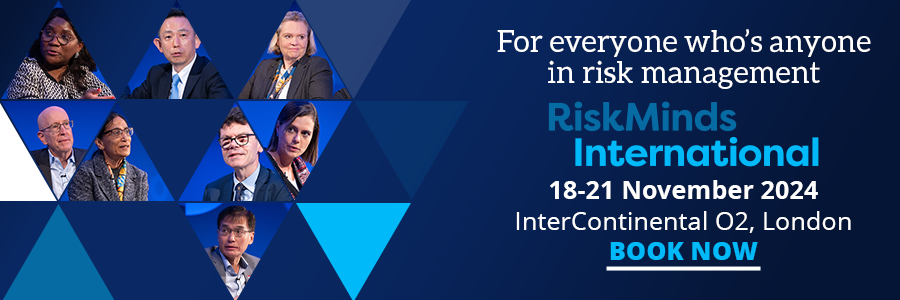Bolstering market & credit risk frameworks in a volatile environment

The volatile economic environment has pushed traditional risks like credit and market risk to the forefront of CROs’ concern. With challenges abound, especially on the climate and ESG front, there are also opportunities and innovations to consider, such as the integration of artificial intelligence or generative AI.
While US interest rates are now in the 4.75% to 5% range, the fact that the Federal Reserve Chair, Jerome Powell, cut rates by 50 basis points in September – with a further 50 basis point cut anticipated by year-end – could initiate a lending boom. In a recent article published by Retail Banker International, it was suggested that banks would need to increase spending on their credit risk management processes, potentially by integrating more AI and machine learning technology tools into their system architecture. Certainly, AI is already proving helpful in respect to customer creditworthiness, and as GenAI technology innovation accelerates, the predictive capabilities for detecting loan defaults should likewise accelerate.
Higher interest rates over the last two and a half years have proven lucrative for global banking groups, with JP Morgan leading the pack in investment banking revenues. Total global bank revenues are forecast to reach $7 trillion in 2024, with a net income of $1.1 trillion but for smaller banks, pressures remain on higher deposit costs and a decline in net interest margins.
One of the key areas of concern for many banks, large and small, has been managing the credit risk exposure of commercial real estate; a sector which has been hit particularly hard by higher rates. Christopher McGratty, head of US bank research at KBW was quoted by CNBC as saying: “There’s a handful of banks that have done a very good job managing the rate cycle, and there’s been a lot of banks that have mismanaged it.”
Effective interest rate risk management is therefore crucial. Banks must adapt their strategies to mitigate a variety of emerging credit-related vulnerabilities linked to geopolitics and the impact on the global economy, ESG risks, and market risks in a climate of heightened volatility. How much investment they choose to make in AI-related technologies, versus human investment to bolster their risk operations teams, presents plenty of challenges for CROs in the current environment.
Regarding volatility, one of the sessions at RiskMinds International will cover how CROs and quant teams model and prepare for extreme risk events. “Extreme VaR, ES and reverse stress testing a catastrophe: projecting gains and losses above 99% for market and counterparty credit risk” will consider the limitations of traditional Historic VaR and Monte Carlo risk models. Tail association measures during periods of market stress are vital for identifying potential risk concentrations, which, left unchecked, could lead to significant financial losses. However, Copula models use random variables to help CROs more accurately model the distribution of joint risks, providing a more nuanced understanding of joint tail behaviour.
AI-enhanced credit risk assessments
Another key topic that will be discussed at RiskMinds International will be Transforming Credit Risk with Generative AI. A recent article published by Risk.net highlighted that credit file monitoring is one area, in particular, that could benefit from digitisation. The comment piece suggested that credit and loan portfolio reviews take up anywhere from 25% to 75% of staff time. This is because banks still tend to rely on manual risk analysis, “especially in corporate lending”.
Ensuring accurate and timely data is crucial for assessing credit risk, yet many banks struggle with data integrity issues. The complex, siloed nature of their infrastructure can often make it hard to centralise data for effective risk assessment and decision-making.
This can lead to bottlenecks in borrower staging, for example, relying on a combination of internal data from transactional logs, relationship manager inputs and external data sources. GenAI tools are now being used to help banks streamline the loan origination process and improve risk oversight. Application areas include:
- Automated document processing, to reduce manual error risk
- Fraud detection
- Tailored loan origination based on individual borrower profiles
Also, by virtue of being able to absorb vast data sets, GenAI tools give banks the capability to develop more sophisticated credit assessments and reduce biases typically found in traditional scoring models.
Accessing a wider source of data can give banks greater reassurance as they consider new market opportunities. The more statistical information they can plug in to their risk frameworks, the better. The GEMs Consortium – a group of 26 multilateral development banks (MDBs) and development finance institutions (DFIs) – recently released two reports on credit risk in emerging market economies; one providing insights on the credit performance of lending to private and public counterparts, the second providing insights on default rates and recovery rates. Such data sources can help CROs refine their risk models in markets where lending activities need to be carefully considered.
Climate-related credit risks
Climate change has, in recent years, become inextricably linked to market risk requiring banks to incorporate climate related-risks into their credit assessments, as they assess borrowers’ creditworthiness. To do this, many are increasingly utilising scorecards to evaluate ESG risk exposure for clients. This is helping to identify areas for improvement as well as assess overall portfolio risks. And as banks increasingly adopt digital transformation (as per GenAI references made above), it is likely to help improve data collection and analysis of ESG risks across their balance sheets.
Indeed, one aspect of strengthening their overall risk management practices is for financial institutions to integrate climate stress tests in order to quantify what the financial impact could be. This is borne out by the fact that companies/borrowers with higher ESG credentials benefit from lower financing costs, as they represent a lower credit risk to the bank.
The reality is that the global economy will increasingly function – and generate volatility – based on climate-related activities. And banks will be required to evolve their credit risk frameworks in lockstep.
